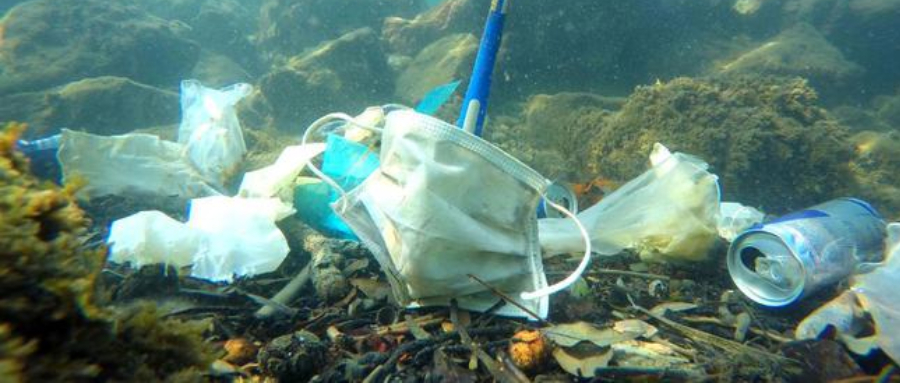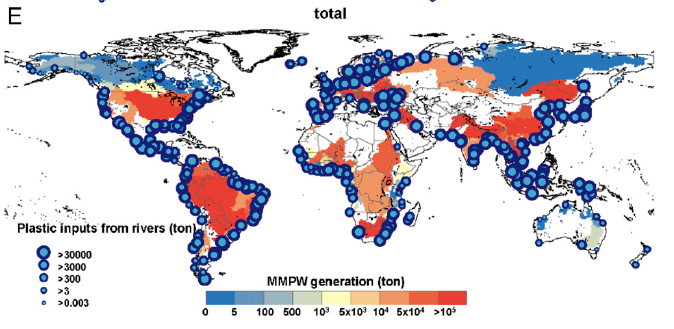

The exponential increase of demand for disposable personal protective equipment (PPE) since the onset of COVID-19 outbreak has added more pressure to the already challenging plastic waste disposal problem. Two recently published studies have caught the attention of policymakers concerned with waste management and circular economy. On November 21, 2021, a report co-authored by China's Nanjing University and the University of California, San Diego, titled “Plastic waste release caused by COVID-19 and its fate in the global ocean”[1] was published in the Proceedings of the National Academy of Sciences of the United States of America, this is one of the first studies to quantify the impact of plastic waste caused by COVID-19.
The other, titled “Innovation in manufacturing personal protective equipment - toward sustainability and circularity” (PPE Report in short) [2], published by International Finance Company (IFC) and UK Aid in October 2021, focused on personal protective equipment and its plastic waste since the onset of the pandemic, to discuss the possibilities of circular economy in the protective equipment industry in the post-pandemic era, as well as examples of companies that are producing circular PPE.
Hazards of PPE waste
In the early days of the pandemic, media have reported the spread of PPE waste globally. Scientists have also long expressed concern about the hazards of PPE waste. According to the PPE report, Shanghai saw a 1,120% increase in hazardous waste and a 71% increase in recyclable waste in June 2020 compared with the same period in 2019. Billions of disposable face masks and face shields are being discarded every day as the pandemic spreads around the world. Each kilogram of plastic waste emits 1.9kg to 3.5kg of carbon. Up to 193 countries generated about 8 million tons of covid-19 related plastic waste, of which about 26,000 tons have now entered the ocean ecosystem, posing a threat to marine life.
After discarded PPE enters the water, plastic particles would decompose into micro particles in the ocean, which are absorbed by marine organisms, directly affecting ocean health and biodiversity, influencing fertility of marine organisms, and will eventually enter the human body through the food chain. Although these do not cause immediate harm, the impacts and damage are significant and long-term. According to simulation of Nanjing University, plastic waste caused by the pandemic will flow from inland rivers to the ocean within three years, where it will be broken down and transferred from the upper layers to the ocean floor or reach the local beaches, with the shoreline directly downstream from areas of waste generation being most affected.
Figure 1: Amount of plastic waste generated due to the pandemic (in tons, red means more and blue means less) and plastic waste discharged from rivers (in tons, the bigger the blue circle is, the more plastic waste is discharged from rivers) [3]

The impact of plastic waste generated by PPE is not only reflected in the increase of waste, but also in the unprecedented spread of plastic waste while the pandemic spreads to every corner of the globe. Primitive tribes and island nations, which previously used little plastic, are directly or indirectly affected by the PPE waste problem, and it is exacerbated by their poor recycling capacity for PPE waste.
The importance of circular economy in PPE production
PPE cycling innovation is critical for both environmental and human health in the post-pandemic era. PPE production requires innovative product design, keeping in mind its recyclability starting with the sourcing the raw material. Post-use treatment of PPE products needs to be taken into account in product design, especially in plastics. If its full life cycle is taken into account at the design stage, transparent, single, single-layer plastic materials that are easy to recycle will be used in production, rather than multi-layer mixtures that cannot be easily recycled.
The PPE Report describes four different stages of circular production, which are: circular inputs, resource recovery, product use extension, product as service.
Circular inputs
The first step of circular innovation is to achieve circular inputs in PPE manufacturing to ensure the recyclability of raw materials. Plastics in PPE can be replaced with non-plastic products, such as masks can use organic plastics or other degradable organic raw materials. Studies have shown that replacing existing plastic products with organic materials can reduce CO2 emissions by 30-70%. These raw materials include cactus, bamboo, banana, wheat, coffee, tea and other bio-degradable products. While replacing the traditional raw materials, it’s also crucial to ensure the substitution can meet the medical safety standards. Companies need to develop innovative new raw material acquisition methods and processing procedures.
Resource recovery
Large-scale and efficient recycling of PPE is the biggest potential breakthrough for effective circular economy. There are many different processes of recycling, including waste recycling, upstream recycling, downstream recycling and energy recycling. In the early stages of production, manufacturers should focus on reducing waste generation, planning for the use and recycling of raw materials, and minimizing material waste in the production process. The raw materials discarded in the production process can be directly used as the raw material for other products. PPE recycling is straightforward in theory, but difficult to implement. In the process of PPE recycling, only with the cooperation of the related parties at all levels can achieve truly safe and effective recycling.
Figure 2: Four steps of resource recovery[4]

Waste separation at source: If medical waste from hospitals and isolation centers with high virus risk can be separated from other civilian medical waste at the time PPE is discarded, it could save a lot of resources for later disinfection and transportation.
Collection: Medical waste collected from hospitals and isolation centers with high infection risk accounts for 10-25% of total used PPE and should be separated and transported to specialized centers for disinfection and destruction. Non-high risk PPE, which accounts for 75-90%, can be recycled after disinfection.
Disinfection: The infection risk of municipal waste is relatively low, and it is disinfected after recycling to futhur reduce its risk. The method for disinfection process depends on the PPE material, quantity, usage and size. The appropriate method is between high temperature and high pressure disinfection and chemical disinfection.
Post-disinfection application: Disinfected PPE can be recycled or broken down for use in the production of new products. In this process, manufacturers have to make sure that recycled products are actually returned to the raw material state for the use of new products.
Product use extension
Extending the product life span can effectively reduce the overall PPE numbers required. The quality and design of the product needs to be considered to maximize its reusability and recyclability. Some PPE can be safely reused through replacement of parts and effective disinfection. For example, protective suits made by a Thai company can be recycled 50-100 times through autoclave technology. Many masks on the market can be reused after the filter layer is replaced. Using cloth textiles to manufacture PPE can be very easy to clean and reuse, while other companies use silicone products to manufacture PPE, to ensure its protection and convenient disinfection.
Products as service
The potential of protective clothing rental and sharing services allows existing resources to increase utilization and reduce unnecessary waste. Services can also be extended through information technology to ensure that waste PPE is effectively recycled with data to prove the company that recycles did indeed break it down for reuse and reproduction. This series of data is also used to prove the effectiveness of circular economy.
The examples of circular PPE shared in the report utilize the four circular economy methods mentioned, reducing the waste of PPE through innovation and using existing resources. The cost of recyclable protectors is generally lower than that of disposable protectors over its life cycle. For example, the replaceable filter layer produced by Open Standard Industries in the US in collaboration with MIT graduates can be sterilized as an alternative to N95 masks and costs less than using disposable N95 masks after 20 uses. Recyclable masks are also more comfortable and easy to wear, bringing convenience to medical workers. However, this requires the buyer to keep circular economy in mind before the purchase, and see the advantage of the long-term cost saving, rather than just seeing the higher per unit cost comparing to disposable masks. In another example, after effective disinfection, the plastic components of used PPE can be decomposed and recycled for the production of raw materials for other products. An Indian company uses recycled medical waste as a component of the bricks for road construction. The PPE recycling project by Northern Michigan University in the United States, "RightCycle", is to recycle products that are difficult to recycle, such as protective clothing, protective glasses and other medical products into plastic pellets, and use them in the production of outdoor furniture, flower pots and other products.
From scale to innovation: Challenges for large PPE production countries
In the global fight against COVID-19, Asia accounts for only 31% of coronavirus cases worldwide, but 72% of the global volume of medical waste. The report from the University of California and Nanjing University sets out a vision to advocate for prevention and effective recycling of plastic waste associated with COVID-19 in developing countries in Asia. China and India, the world's two largest PPE producers and exporters, both are located in Asia, with China accounting for nearly half of global PPE production and producing 200 million masks per day in mid-2020. However, domestic PPE waste recycling has not been emphasized.
In the foreseeable future, the problem of the PPE waste pollution needs the attention and hard work of various levels of stakeholders' collective efforts as the demand of PPE will continue to be high. The case studies in the report can help the PPE manufacturers to speed up their product innovation, the government also needs to promote the development of circular economy policies and regulation. Its also critical to increase public consumers’ awareness and purchase support for sustainable PPE products. After all, using the development of circular economy as an opportunity to promote the innovation of sustainable PPE production requires the coordination and joint efforts of all stakeholders.
Note:
[1] Peng et al (2021) Plastic waste release caused by COVID-19 and its fate in the global ocean. PNAS 2021 VOL. 118 No.47 e2111530118. Link: https://doi.org/10.1073/pnas.2111530118
[2] UK AID and IFC (2021). Innovation in manufacturing personal protective equipment - toward sustainability and circularity. Link: https://www.ifc.org/wps/wcm/connect/industry_ext_content/ifc_external_corporate_site/manufacturing/resources/innovation+in+manufacturing+personal+protective+equipment
[3] 同1
[4] 同2
Author:Pan Yiren
Translation: Pan Yiren
Proofread by Zhao Ang & Li Ying
This article is an original article of the Rock Environment and Energy Institute. Please contact us to obtain the appropriate authorization to reprint. For cooperation and authorization, please send an email to: liying@reei.org.cn
* This is the translation of an article in Chinese. Should there be any inconsistency between Chinese and English version, the Chinese version shall prevail.




